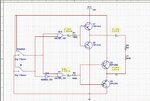boylesg
Advanced Member level 4

- Joined
- Jul 15, 2012
- Messages
- 1,023
- Helped
- 5
- Reputation
- 10
- Reaction score
- 6
- Trophy points
- 1,318
- Location
- Epping, Victoria, Australia
- Activity points
- 11,697
If you have a diode clamp (using 1n4148 for example) on the input of logic gate, then would that pin then still be regarded as floating?
Would you still need a large value resistor to GND in order to give it a definite state as far as the logic gate goes?
Would you still need a large value resistor to GND in order to give it a definite state as far as the logic gate goes?

